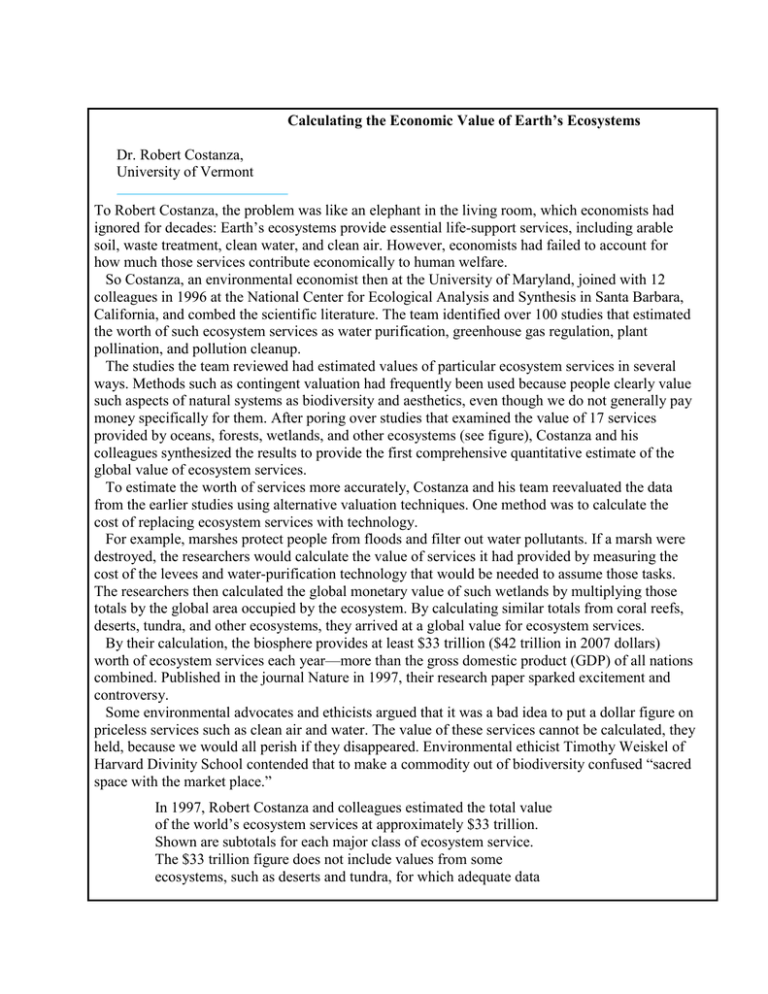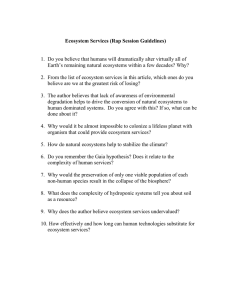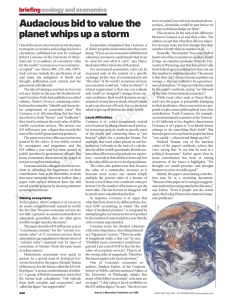Dr. Robert Costanza, University of Vermont
advertisement

Calculating the Economic Value of Earth’s Ecosystems Dr. Robert Costanza, University of Vermont To Robert Costanza, the problem was like an elephant in the living room, which economists had ignored for decades: Earth’s ecosystems provide essential life-support services, including arable soil, waste treatment, clean water, and clean air. However, economists had failed to account for how much those services contribute economically to human welfare. So Costanza, an environmental economist then at the University of Maryland, joined with 12 colleagues in 1996 at the National Center for Ecological Analysis and Synthesis in Santa Barbara, California, and combed the scientific literature. The team identified over 100 studies that estimated the worth of such ecosystem services as water purification, greenhouse gas regulation, plant pollination, and pollution cleanup. The studies the team reviewed had estimated values of particular ecosystem services in several ways. Methods such as contingent valuation had frequently been used because people clearly value such aspects of natural systems as biodiversity and aesthetics, even though we do not generally pay money specifically for them. After poring over studies that examined the value of 17 services provided by oceans, forests, wetlands, and other ecosystems (see figure), Costanza and his colleagues synthesized the results to provide the first comprehensive quantitative estimate of the global value of ecosystem services. To estimate the worth of services more accurately, Costanza and his team reevaluated the data from the earlier studies using alternative valuation techniques. One method was to calculate the cost of replacing ecosystem services with technology. For example, marshes protect people from floods and filter out water pollutants. If a marsh were destroyed, the researchers would calculate the value of services it had provided by measuring the cost of the levees and water-purification technology that would be needed to assume those tasks. The researchers then calculated the global monetary value of such wetlands by multiplying those totals by the global area occupied by the ecosystem. By calculating similar totals from coral reefs, deserts, tundra, and other ecosystems, they arrived at a global value for ecosystem services. By their calculation, the biosphere provides at least $33 trillion ($42 trillion in 2007 dollars) worth of ecosystem services each year—more than the gross domestic product (GDP) of all nations combined. Published in the journal Nature in 1997, their research paper sparked excitement and controversy. Some environmental advocates and ethicists argued that it was a bad idea to put a dollar figure on priceless services such as clean air and water. The value of these services cannot be calculated, they held, because we would all perish if they disappeared. Environmental ethicist Timothy Weiskel of Harvard Divinity School contended that to make a commodity out of biodiversity confused “sacred space with the market place.” In 1997, Robert Costanza and colleagues estimated the total value of the world’s ecosystem services at approximately $33 trillion. Shown are subtotals for each major class of ecosystem service. The $33 trillion figure does not include values from some ecosystems, such as deserts and tundra, for which adequate data were unavailable. Data from Costanza, R., et al. 1997. The value of the world’s ecosystem services and natural capital. Nature 387: 253–260. Some economists, meanwhile, disparaged the methods by which the researchers calculated values. Replacement costs were not a legitimate way of determining value, they held, because nature’s services, like other economic goods and services, are worth only what people will demonstrably pay for them. Critics also argued that combining the value of ecosystem services from various small tracts of land is meaningless because people decide whether to preserve or exploit resources based on particular local considerations, not on generalized global ones. To address criticisms, Costanza joined Andrew Balmford of Cambridge University and 17 other colleagues to conduct another analysis. They compared the benefits and costs of preserving natural systems intact with those of converting wild lands for agriculture, logging, or fish-farming. Again, they synthesized studies on ecosystem services, this time focusing on just five ecosystems: West African and Malaysian tropical forests, Thai mangrove swamps, Canadian wetlands, and Philippine coral reefs. In their paper, published in the journal Science in 2002, the team reported that a global network of nature reserves covering 15% of Earth’s land surface and 30% of the ocean would be worth between $4.4 and $5.2 trillion. This amount is about 100 times the value of the same areas were they to be converted for direct exploitative human use. That 100:1 benefit-cost ratio, they wrote, demonstrates clearly that “conservation in reserves represents a strikingly good bargain.” “Calculating the Economic Value of Earth’s Ecosystems” Environment: The science behind the stories, pages 50-51 Reading Questions: 1. What “life support services” does Earth’s ecosystem provide? 2. What were Costanza and his 12 colleagues attempting to do? 3. Why do you think economists had “failed to account” for ecosystem services? 4. Explain Costanza’s method of calculating the cost of replacing ecosystem services with technology. 5. How much economic value does our Biosphere provide according to the article? 6. Why did people (environmentalists, ethicists, and economists) criticize Costanza’s study? 7. How was Costanza’s second study different? 8. Why does Costanza conclude that “conservation in reserves represents a strikingly good bargain?” Reflection Questions 9. Why do you think that some ecosystem services, such as nutrient cycling or water treatment is so valuable? 10. Do you agree with Costanza’s conclusion? If so, how can people be convinced to draw the same conclusion? If not, why not?







